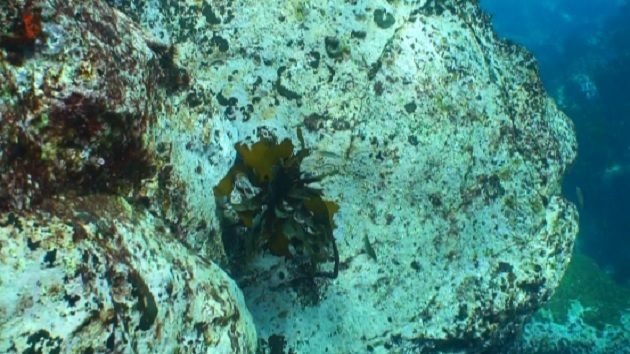
The seabed around Jeju is losing a lot of its plant and animal life-a phenomenon called “whitening.” Billions of won have been spent on the issue, but with little effect. Joseph Kim reports.
The seabed under the clear water is dominated by a greyish-white coralline algae. This phenomenon is called “the whitening of the sea.”
It prevents green seaweed and macro algae from rooting itself on rocks.
[slug]
‘Whitening event’ results in lifeless seabed
Due to climate change and the discharge of waste into the ocean, Jeju waters are being severely affected by this phenomenon. This has led to a lack of marine life in the water.
The whitening of the seas surrounding Jeju has been observed since 1992.
The Korea Fisheries Resources Agency researched 15,000 hectares of coastal areas around the island.
Researchers report that 5,500 hectares or 36 percent of all fishery areas on Jeju’s coastline are affected by this phenomenon.
2,400 hectares have become severely deforested.
The Korea Fisheries Resources Agency has replanted and restored marine ecosystems along the Jeju coastline since 2009 to stop the whitening of the seas.
The agency has also cultivated seaweed -also called macro algae-on artificial structures and placed the structures on 5,060 hectares of Jeju coastal areas.
This year it will drop the seaweed planted artificial structures at six spots to cover about 1,000 hectares.
INTERVIEW
Han Eun-gyu / Korea Fisheries Resources Agency
Fish and aquatic plants along Jeju’s coastline are now facing a lack of food and habitat. To stop the phenomenon, we’ve planted seaweed in the Eastern, Western, Southern, and Jeju Seas.
<인터뷰 :한은규 / 한국수산지원관리공단 연구원 >
"갯녹음에 의해 수산 자원이 많이 저하됐습니다. 이를 극복하기 위해 수산지원관리공단에서는 해마다 제주와 동해, 서해, 남해에 바다 숲 조성을 하고 있습니다. "
For the restoration project, 6 billion won has been spent.
This year 8.5 billion won will be additionally used for the reforestation.
However, the efforts have not paid off.
There has been no significant result except that the amount and varieties of macro algae have increased a little more than ten percent.
On average, the greyish-white coralline algae additionally dominates 1,200 hectares of coastal areas every year.
[slug]
Second worst ‘whitening’ in the nation
Researchers report that the whitening of the sea in Jeju is the second worst in the nation.
As the rising seawater temperature and discharge of waste into the ocean are the main culprits of the whitening,
[Reporter] Joseph Kim
[Camera] Kim Seung-cheol
authorities’ need to take aggressive action to tackle climate change and reduce water pollution to fight against invasive species and the whitening of the Jeju sea.
Joseph Kim, KCTV





